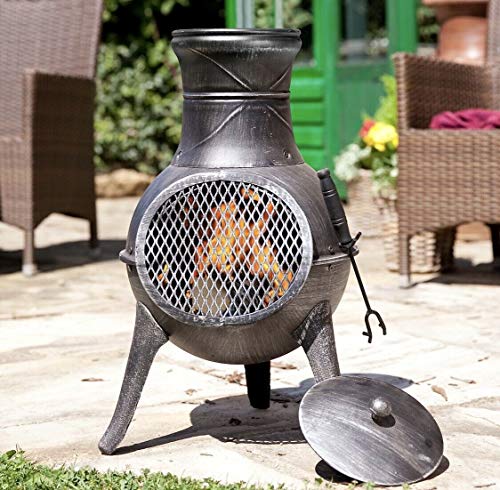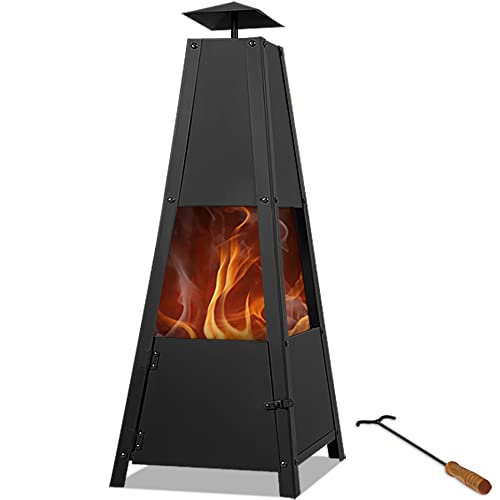원글

Chimineas - An Authentic Mexican Fire Pit
Originally designed to be bread ovens Chimineas represent Mexico's rich cultural heritage. The simple design, blending practicality and aesthetic simplicity, is timeless.
Clay chimineas can be fired in kilns which remove organic materials from the clay and seals the pores to prevent cracking. They are designed to live outdoors all year long, but should be protected from prolonged exposure to the elements.
Origins
Imagine a warm summer evening with family and friends, savoring delicious food in a beautiful outdoor space, kept warm by the gentle warmth of your clay or Mexican chiminea. It's a scene that is reminiscent of the Mexican roots of this type of outdoor fire pit.
These stoves, which were terra-cotta in origin, were designed to serve as radiant heaters and ovens, aiding tribesmen during the cold desert nights of their homeland. Their distinctive design was inspired by their utilitarian values that stressed practicality and communal living.
Originally these stoves were constructed from natural terra-cotta clay which was dried before being fired wood in kilns. Chimineas made of clay are more rustic in appearance and were not glazed to protect the surface. Modern manufacturers make chimineas from metals such as brass, cast iron, and aluminum. These materials are more robust and resistant to weathering, which is one of the main limitations of the clay design.
The unique design of the chiminea was influenced by the concept of a pot-bellied base which rises up into an extended chimney. This shape is perfect for containing a fire while directing smoke upwards. This reduces air intake and maximizes heat retention.
Chimineas were utilized for cooking as well as heating and lighting for the tribal people of Mexico. We can still enjoy their design and the warmth they provide in the chilly autumn evenings, or even in the brisk winter sun.
No matter if your chiminea's an authentic Mexican piece or a more modern version, Gardeco has a choice of different styles to match your garden and decor. We carry a wide selection of sizes, ranging from small and medium to extra-large and Jumbo. We also offer clay chimineas that have decor that is either moulded or engraved into the body of the item.
Our selection of terracotta and Mexican chimineas are handmade by artisans from the center of Mexico. Colours and shapes may vary slightly due to the nature of the manufacturing process. If your chiminea starts to fade, you can always repaint it with an water-based emulsion. It is essential to follow the manufacturer's instructions and care guidelines prior to using your new chiminea the first time.
Design
Chimineas are not just practical, but they also give an authentic and rustic look to the space. They are available in a variety of styles and materials, and they can be combined with any patio furniture. They can be a focal point or blend seamlessly into the surrounding landscape.
The traditional chimenea made of clay, was created with both practical and historical significance in mind. Its tall, chimney-like neck directed smoke away from its users and its rounded round body radiates warmth. It was also used to socialize and tell stories, playing a significant role in Mexican and Central American cultures.
Traditional
chimineas Uk are crafted by local artisans using wet clay that is taken directly from the earth. The clay was then formed into its final shape before being dried by kiln. Clay chimeneas are very labor-intensive to make particularly big ones. Typically the potters would roll long snakes of clay into a circular shape, and then smooth the clay together and create the chiminea's neck and bowl. The clay's rim was often decorated with patterns and carvings.
A modern chiminea is usually constructed from metal, such as cast iron or aluminum. The introduction of chimineas made from metal was a significant step forward because they are able to endure high temperatures and extreme moisture without cracking. This modification allowed chimineas be used in a vast range of climates.
Although there are a number of companies that make clay and terracotta-based chimineas the majority of chimineas are now made from metal. Metal chimineas last longer and are easier to clean. These factors have made chimineas made of metal more popular than clay counterparts.
It doesn't matter what kind of chiminea is selected it is essential to place it in the right place. It must be placed in a level area far from any flammable items like grass, trees or other structures. The chiminea should also be placed on a concrete, brick, or stone patio and never on a wooden deck. It's also a good idea to put 50mm of sand or Gardeco lava stones beneath the
chiminea and grill to protect it from direct heat and keep the hottest part of the fire from the clay.
Materials
Kiln-fired terracotta and clay chimineas are still being produced by small-scale factories. The temperatures can reach up to 1000 degrees Celsius. After they have been cooled and cured they are then assemble. Some are glazed, while others remain unglazed. These chimineas are a popular choice since they give an authentic Mexican look to a garden.
Chimineas are hand-painted in a variety of colours and patterns to suit different styles. The paint finish will fade due to time and temperature of the fire, so it's best to re-paint with an emulsion that is water-based.
While originally intended to be essential elements of heating and cooking for city-dwelling Mexicans Chimineas have also embodied an appreciation for cultural heritage over the centuries and have adapted to a variety of requirements for functional purposes. These distinctive structures weren't solely used by indigenous people of Mexico as bread ovens as well as played a significant role in repelling bugs and encouraging social gatherings.
The unique design of a chiminea, with a broad base and narrow chimney spout, allows the most air to be drawn in from the bottom of the structure, which reduces smoke inhalation. It also helps retain the heat inside the chiminea, making it ideal for cooking over.
Today, chimineas can be found in various materials, including terracotta clay, cast iron and even aluminium. Terracotta chimineas offer the classic Mexican look. However, they are prone to crack under pressure and should only be placed on a flat, fire-safe surface. Cast iron and aluminium chimineas are less susceptible to damage, while remaining stylish and durable.
To ensure that the chiminea will last as long as you can, place it in a location that is well ventilated and shielded from wind and rain. It should be placed away from any walls and structures that might catch alight, as well as any roofs on patios or eaves that may be damaged by the sudden shift in temperature that occurs when the chiminea is removed. In order to prevent the
chiminea metal from burning too much, it's recommended that leaves are not burned and only well-seasoned, kiln-dried logs be burned. Regular cleaning with a wire brush is also essential, as it will prevent build up of deposits that could cause the chiminea to burn and turn black. The chiminea can be shielded from wind, which will reduce the amount smoke that it releases.
Maintenance
Like any other fire apparatus the proper maintenance is crucial to ensuring the longevity of your chiminea. This can prolong its life and ensure that it functions safely. Chimineas can be fragile, and should be kept outside where they can be cared for. Even if a chiminea made of clay appears sturdy but it is still susceptible to cracks and break due to various causes. This is why it's crucial to examine your chiminea on a regular basis for signs of wear and tear and to follow the manufacturer's recommendations on how often it should be fired.
To keep your mexican chimney looking good you must clean it thoroughly with a mild detergent. This will remove any dirt and grime that may cause discoloration or corrosion. To remove loose rust particles you should use a wire brush. It is recommended that gloves and goggles be used to protect. After scrubbing your chiminea clean, rinse it and allow it to dry completely. This will prevent any water from causing corrosion and can also prolong the lifespan of your chiminea.
After the chiminea has been cleaned and dried, you should lightly sand it down using fine-grit sandpaper. This will smooth the surface and eliminate any rough spots that could catch on to the embers as you build an open flame. Sanding can also make the surface more even and attractive. Sanding can be followed with several coats of grill or stove paint to improve the appearance and safeguard your
chiminea fire pit from corrosion.

It is also recommended that you keep your chiminea away from direct sunlight and winds, as this can cause the paint to peel and fade. It is possible to fix the problem by using water-based emulsions paints or masonry sprayed. It is also essential to only add a few pieces of wood at a time and build small fires to your chiminea so that you can "break it into" and to avoid overheating.
